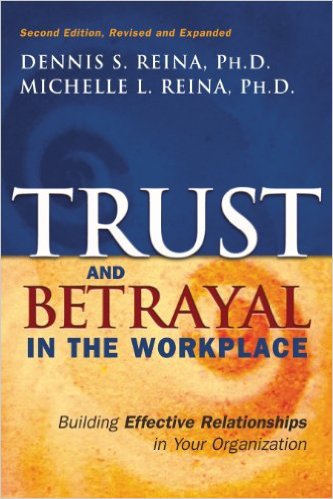Trust and Betrayal in the Workplace

I’ve been trying to crystallize some thinking on building adoption and engagement for SharePoint implementations which lead me to models for change and John Kotter’s Leading Change book. Step 2 of his 8 step process is to Creating a Guiding Coalition. There are aspects of building the coalition that Kotter covers well: Position Power, Expertise, Credibility, and Leadership – however, inherently there’s the component of trust that’s missing in his discussion of this topic. Credibility touches ever so slightly on it. Credibility is a specific trust around someone but I believe this issue of trust and being a part of a team is much more.
I read the book Building Trust: In Business, Politics, Relationships, and Life – but it was a philosophy discussion not a discussion of how to break down trust and how to create it. I picked up Trust & Betrayal in the Workplace by Dennis and Michelle Reina looking for something more solid and direct. I was very pleased to see them take trust and break it into components. To look at each part and way that we trust – and in so doing created the opportunity to realize what builds trust – and what destroys it.
Trust & Betrayal in the Workplace defines three types of transactional trust and associated components (I paraphrased some of the below to match my thinking):
-
Contractual
- Managing Expectations
- Establishing Boundaries
- Delegating Appropriately
- Mutual Intentions
- Keep Agreements
- Being Congruent
-
Communication
- Share Information
- Tell the Truth
- Admit Mistakes
- Give/Receive Feedback
- Maintain Confidentiality
- Speak Directly
-
Competence
- Acknowledge Skills/Talents
- Allow Decisions
- Involve Others/Seek Input
- Encourage Learning
In addition to the awareness of different kinds of trust, there are also models for recovering from betrayal – which is a natural part of trusting someone. You’re going to find that you are betrayed sometimes. Most of those betrayals will be small and unintentional – but not all of them.
The end of the book includes a concept of transformative trust that relies on conviction, courage, compassion, and community. In my opinion, this “higher level” trust is the kind of trust which radiates and encourages others to trust – and it’s the kind of trust that’s demonstrated by some of the best leaders.
If you’re struggling with an organization where there’s little trust and lots of betrayal you may find that the book Trust & Betrayal in the Workplace is just what the doctor ordered.
